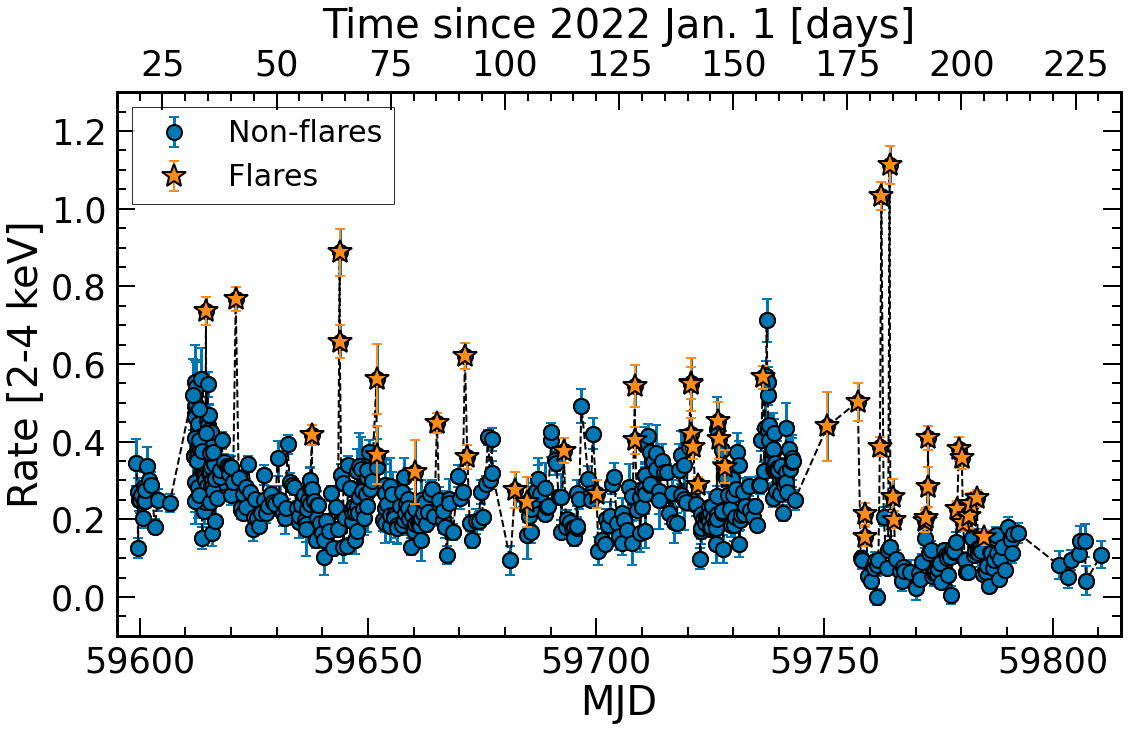NICER / ISS Science Nugget
for March 9, 2023
Peculiar X-ray flares in a supermassive black hole binary candidate
Supermassive black holes (SMBHs) reside at the center of nearly every galaxy, and therefore, binary SMBHs are a natural consequence of galaxy mergers. To date, there have been a number of binary SMBHs claimed, but the discovery of a merging SMBH system has been elusive thus far. This is expected to change in the near future when space-based gravitational wave detectors are launched, but for now electromagnetic signatures of SMBH binaries are our best bet for discovering close-separation (i.e., near merger) binary SMBHs. To that end, early last year, Jiang et al. (2022) announced that they had found a binary SMBH that was within 3 years of merging, based on a sinusoidal optical light curve that had a rapidly decreasing period. This announcement caused quite a stir in the astronomy community and numerous telescopes pointed to this intriguing system known as "Tick Tock" (or AT2019cuk in the typical astronomical transient naming convention). NICER was among the many telescopes that observed Tick Tock, with NICER's rapid response and high-cadence monitoring campaign leading to one of the strongest probes of the binary nature of the source.
A recent paper led by Megan Masterson (MIT), accepted for publication in the Astrophysical Journal Letters, presents nearly 8 months of NICER monitoring of Tick Tock, with an average of 2 observations obtained every day. The team found that there was no periodic behavior in either NICER X-ray nor ground-based optical observations, thus challenging the binary nature of Tick Tock. Despite this, the NICER data set still revealed something very interesting - the hard X-ray light curve showed repetitive flares that have never been seen before in accreting SMBHs. These flares last for approximately a day in duration, appear to occur stochastically, and result in extremely hard X-ray spectra compared to typical X-ray spectra of accreting SMBHs. After modeling all of the NICER spectra and comparing the flares to the non-flaring data, the team suggested a few different models for the driving mechanism behind the flares. The most favorable model is one in which there is increased magnetic activity in the X-ray corona, a nearly ubiquitous component of accreting black holes that is responsible for the hard X-ray emission we see. Further observations of other SMBH transients will help elucidate whether this behavior is unique to Tick Tock, or a more common property of SMBH transients. But one thing is clear from this analysis: NICER is crucial to studying short timescale X-ray variability in accreting SMBHs and can probe interesting properties of the accretion process that may easily be missed without such dedicated high-cadence monitoring.


Figure:
Left: NICER light curve of the binary SMBH candidate Tick Tock in the hard X-ray band (2-4 keV). This 8-month monitoring campaign totaled over 300 ksec of NICER data spread over more than 600 snapshots. Flares are identified using the ratio between the 2-4 keV count rate and 0.3-2 keV count rate and are shown as orange stars in the light curve. The blue circles show the non-flaring data, which follow a relatively standard variability pattern for accreting SMBHs.
Right: Schematic showing how the flares could arise from increased magnetic activity in the X-ray corona of Tick Tock. In this scenario, magnetic reconnection events in a highly magnetized corona could lead to the observed hardening of the X-ray spectrum with relatively stochastic variability. (Figures from Masterson et al. 2023.)
<< Previous
Main Index